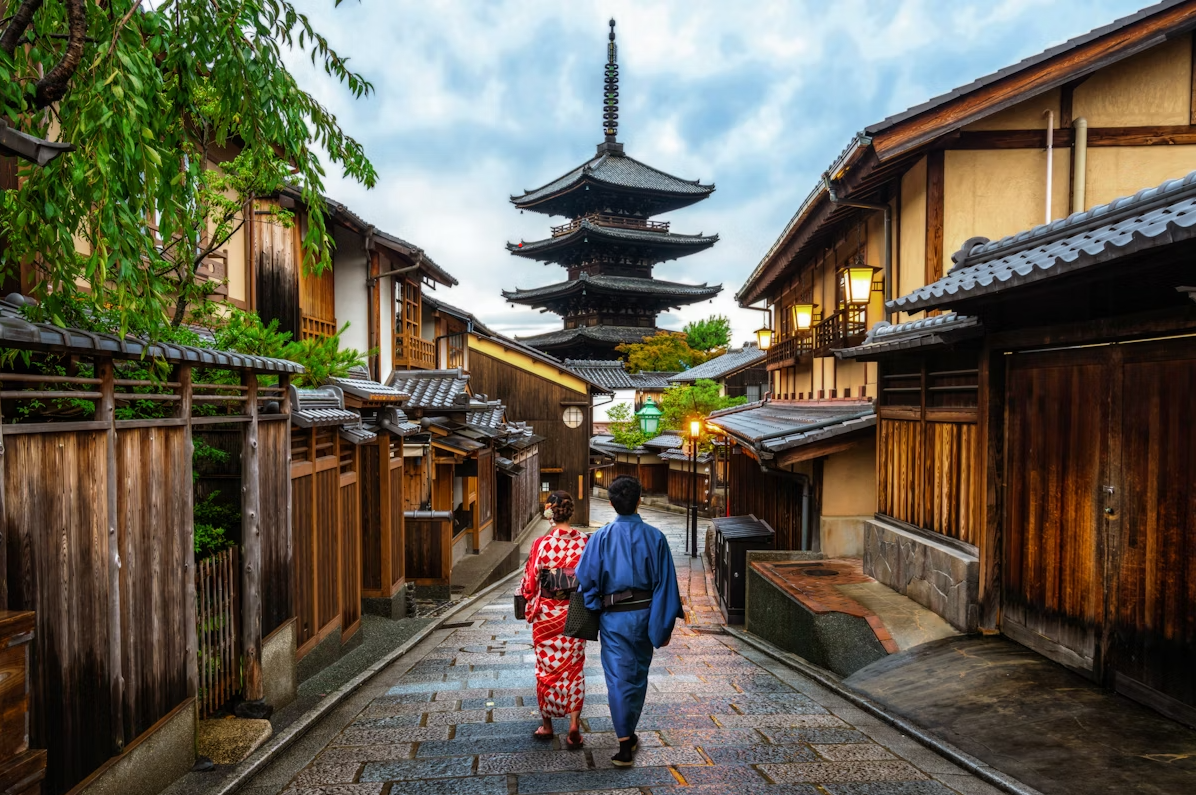Introduction
The Higashiyama District, nestled along the eastern mountains of Kyoto, is one of the city’s most well-preserved historical areas. With its narrow stone-paved streets and traditional wooden buildings, it offers a perfect glimpse into Kyoto’s charm as Japan’s ancient capital. From Kiyomizudera Temple to Yasaka Shrine, visitors can wander through quaint streets and experience the rich historical atmosphere, feeling as if they’ve stepped back in time to Kyoto’s Heian period.
Higashiyama District Highlights
- Well-preserved traditional district with an old capital ambiance
- Numerous famous attractions including Kiyomizudera and Kodaiji temples
- Traditional shops selling unique crafts and local delicacies
- Maruyama Park, a prime cherry blossom viewing spot
- Convenient location for walking tours
- Enjoyable year-round, with spring and autumn being the best seasons
Rich History
The history of the Higashiyama District dates back to the Heian period (794-1185). As an important area east of the imperial palace, it became home to numerous temples and shrines. From the Edo period (1603-1867) onwards, with the increase of pilgrims and tourists, traditional shops and teahouses began to flourish, forming the unique machiya architectural style.
In recent years, to further enhance the historic atmosphere, local authorities have renovated the streets, removing telephone poles and repaving the roads. These efforts have made the Higashiyama District one of the best places to experience traditional Kyoto.
Main Attractions
Kiyomizudera Temple
One of Japan’s most popular temples, Kiyomizudera is famous for its wooden platform offering panoramic views of Kyoto. The view is particularly stunning during cherry blossom and autumn foliage seasons.
- Hours: 6:00 to 18:00 (until 18:30 in July and August)
- Admission: 400 yen
- Highlights: Wooden terrace, pure water spring, love stones
Kodaiji Temple
Built in 1605 by Toyotomi Hideyoshi’s wife to commemorate the great political leader, Kodaiji features exquisite gardens, tea houses, and a bamboo grove, showcasing the essence of traditional Japanese garden art.
- Hours: 9:00 to 17:30 (last entry at 17:00)
- Admission: 600 yen
- Highlights: Zen rock garden, bamboo grove, night illuminations
Yasaka Pagoda
The last remnant of Hokanji Temple, Yasaka Pagoda is one of the most visible landmarks in the Higashiyama District. The interior is occasionally open to visitors, offering a rare opportunity to view a pagoda from the inside.
- Hours: Irregular openings, usually 10:00 to 16:00
- Admission: 500 yen
- Highlights: Five-story pagoda architecture, interior murals
Yasaka Shrine
One of Kyoto’s most popular shrines and the site of the famous Gion Festival, Yasaka Shrine is known for its hanging lanterns that are lit every evening, creating a magical atmosphere.
- Hours: Always open
- Admission: Free
- Highlights: Hanging lanterns, dance stage, Gion Festival
Maruyama Park
Maruyama Park is Kyoto’s most famous spot for cherry blossom viewing. During early April, when the cherry trees are in full bloom, the park becomes a bustling hub of hanami (flower viewing) parties.
- Hours: Always open
- Admission: Free
- Highlights: Cherry blossoms, weeping cherry tree, nighttime illuminations
Best Time to Visit
The Higashiyama District is enjoyable year-round, but spring (March-May) and autumn (October-November) are ideal.
- Spring: Cherry blossoms in full bloom
- Autumn: Vibrant fall foliage and pleasant weather
- Winter: Occasional snowfall creates a unique atmosphere
- Summer: Slightly hot, but less crowded
Getting There and Around
From Kyoto Station:
- Take bus number 206 to Gojozaka stop (10 minutes, 230 yen) or Gion stop (15 minutes, 230 yen)
- Alternatively, a 10-15 minute walk from:
- Kiyomizu-Gojo Station (Keihan Main Line)
- Gion-Shijo Station (Keihan Main Line)
- Kyoto-Kawaramachi Station (Hankyu Kyoto Line)
- Higashiyama Station (Tozai Subway Line)
Opening Hours and Admission
Refer to the “Main Attractions” section above for specific opening hours and admission fees. Most shops are open from 9:00 or 10:00 to 17:00 or 18:00.
Visitor Tips
- Wear comfortable walking shoes as streets are often paved with stones
- Allow plenty of time to fully appreciate each attraction
- Try wearing a kimono for a deeper cultural experience
- Purchase local specialties like pottery or wagashi sweets as souvenirs
- Avoid Japanese holidays like Golden Week and Obon for smaller crowds
- Prepare cash as some small shops may not accept credit cards
Conclusion
The Higashiyama District offers an unparalleled opportunity to experience the traditional charm of Kyoto. As you stroll through its ancient streets, visit historic temples and shrines, and savor authentic Kyoto cuisine, you’ll feel the unique allure of this thousand-year-old capital. Whether it’s your first visit or a return trip to Kyoto, the Higashiyama District is worth savoring slowly, allowing you to discover your own Kyoto memories. Start planning your Higashiyama adventure now and create your most cherished travel experiences! japan.travel

Leave a Reply